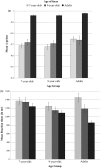Sex Categorization of Faces: The Effects of Age and Experience
- PMID: 30834097
- PMCID: PMC6396056
- DOI: 10.1177/2041669519830414
Sex Categorization of Faces: The Effects of Age and Experience
Abstract
The face own-age bias effect refers to the better ability to recognize the face from one's own age compared with other age groups. Here we examined whether an own-age advantage occurs for faces sex categorization. We examined 7- and 9-year-olds' and adults' ability to correctly categorize the sex of 7- and 9-year-olds and adult faces without external cues, such as hair. Results indicated that all ages easily classify the sex of adult faces. They succeeded in classifying the sex of child faces, but their performance was poorer than for adult faces. In adults, processing time increased, and a response bias (male response) was elicited for child faces. In children, response times remained constant, and no bias was observed. Experience with specific category of faces seems to offer some advantage in speed of processing. Overall, sex categorization is more challenging for child than for adult faces due to their reduced sexual dimorphic facial characteristics.
Keywords: experience; face categorization; own-age bias; sex discrimination.
Figures



References
-
- Anastasi J. S., Rhodes M. G. (2005) An own-age bias in face recognition for children and older adults. Psychonomic Bulletin & Review 12: 1043–1047. doi:10.3758/BF03206441. - PubMed
-
- Boothroyd L. G., Jones B. C., Burt D. M., Cornwell R. E., Little A. C., Tiddeman B. P., Perrett D. I. (2005) Facial masculinity is related to perceived age but not perceived health. Evolution and Human Behavior 26: 417–431. doi:10.1016/j.evolhumbehav.2005.01.001.
-
- Boxer A. M., Tobin-Richards M., Petersen A. C. (1983) Puberty: Physical change and its significance in early adolescence. Theory Into Practice 22: 85–90. doi:10.1080/00405848309543044.
-
- Brown U. E., Perrett D. (1993) What gives a face its gender. Perception 22: 829–840. doi:10.1068/p220829. - PubMed
-
- Burton A. M., Bruce V., Dench N. (1993) What's the difference between men and women? Evidence from facial measurement. Perception 22: 153–153. doi:10.1068/p220131. - PubMed
Grants and funding
LinkOut - more resources
Full Text Sources

